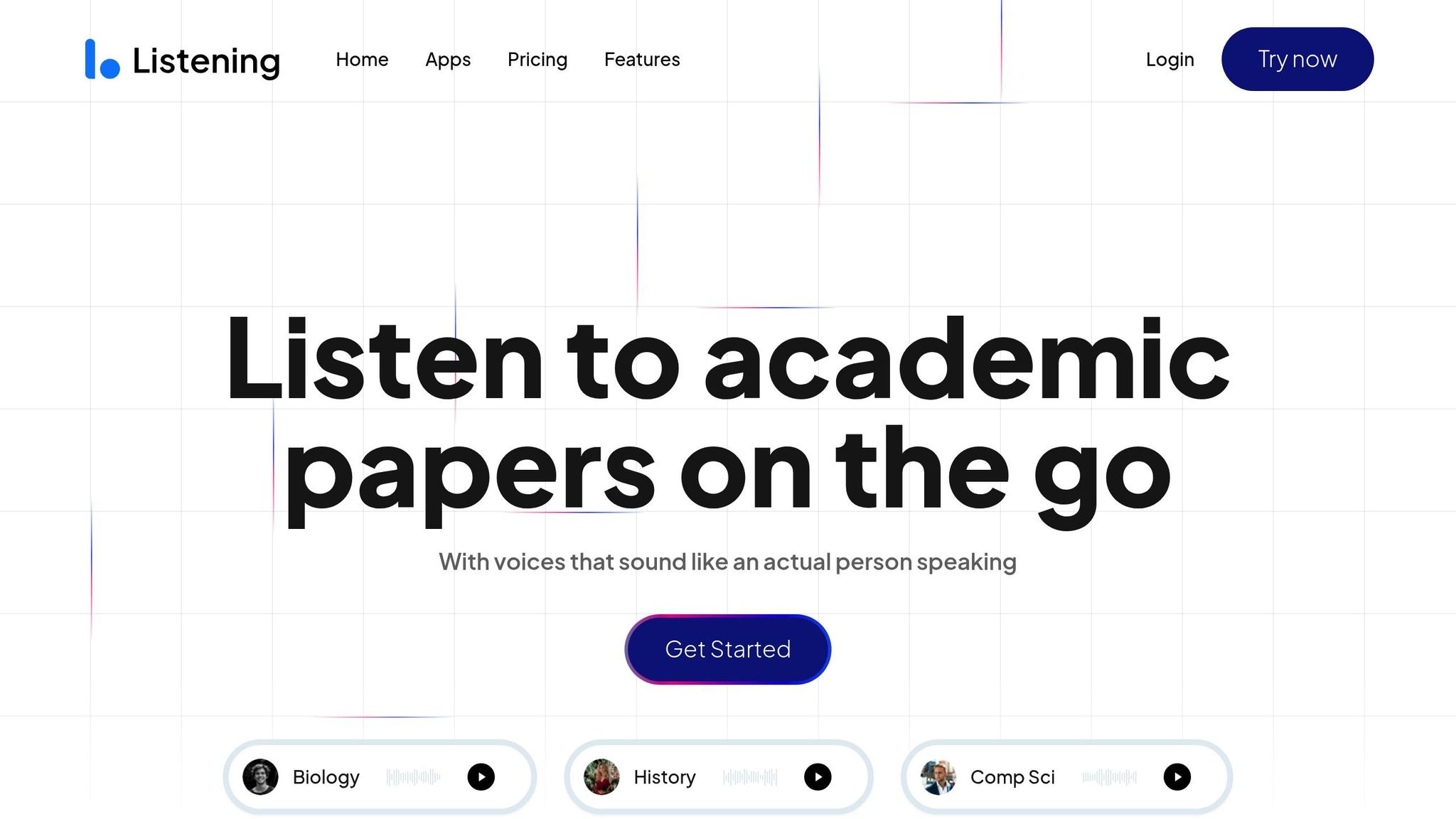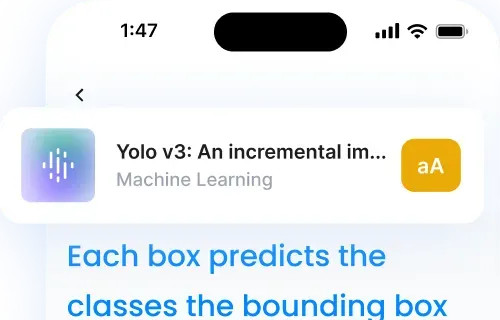Improve Your Reading Efficiency with Text-to-Speech! Tired of struggling to keep up with academic papers? If you’re drowning in dense PDFs and limited on time, it’s time to rethink how you read. Text-to-speech (TTS) technology is a powerful tool for improving reading efficiency—letting you absorb complex content while commuting, exercising, or even doing chores.
Instead of sitting for hours in front of a screen, TTS allows you to listen to research papers on the go. It not only reduces eye strain and mental fatigue, but also helps you stay productive and focused—without sacrificing comprehension. Whether you’re a student, researcher, or lifelong learner, improving your reading efficiency with audio can free up time and help you retain more of what matters.
In this guide, we’ll show you how to use TTS tools to supercharge your academic workflow and take your reading efficiency to the next level.
Key Benefits of TTS for Academic Reading:
- Multitasking: Listen to papers while doing other activities.
- Accessibility: Makes content easier for everyone to engage with.
- Ease of Use: Skip citations, adjust playback speed, and navigate sections easily.
- Reduced Fatigue: Gives your eyes a break while retaining information.
With features like adjustable speed, citation skipping, and synced note-taking, TTS tools like Listening are helping over 50,000 users stay productive. Whether you’re reviewing complex methods or just skimming abstracts, TTS can transform how you approach academic reading.
Want to dive deeper? Let’s explore how to set up and optimize your TTS experience.
Benefits of Text-to-Speech for Reading Efficiency
Listen While Multitasking
Text-to-speech (TTS) allows you to consume research papers while handling other activities. Whether you’re commuting, working out, cleaning, walking, or cooking, you can stay productive.
“This is a lifesaver – I listen to papers during my commute and on the go!” – Mandy Eversole
Improving Accessibility for Everyone
TTS tools make academic content easier to engage with for researchers and students who face challenges like dyslexia or visual impairments. These tools bridge gaps that traditional reading methods can’t always address.
“Clear text display and accurate pronunciation make academic papers accessible to me.” – Róisín Hennessy
This is particularly helpful for:
- Students with dyslexia
- Researchers with visual impairments
Easing Eye Strain and Mental Fatigue
Reading academic papers for extended periods can be tough on your eyes and mentally draining. Switching to audio gives your eyes a break while still letting you absorb information.
Key advantages include:
- Less screen time, reducing eye strain
- Lower mental fatigue with audio-based learning
Next, we’ll guide you on how to optimize your papers for smooth TTS playback.
Step-by-Step Guide to Reading Efficiency with TTS
Ready to make the most of Text-to-Speech (TTS) for reviewing papers? Here’s a simple guide to help you prepare and optimize your documents for audio.
Preparing Your Papers for TTS
Start by converting your papers into compatible formats like PDF, Word, or EPUB. If you’re working with physical documents, scanned text works too.
To keep things organized, group your files into topic-based folders. This makes it easier to focus during your listening sessions. Once your papers are sorted, it’s time to adjust your TTS settings.
Essential TTS Settings to Adjust
- Voice Selection: Pick a natural-sounding AI voice for more enjoyable listening.
- Playback Speed: Begin at 1× speed and gradually increase until you find a comfortable balance between speed and comprehension.
- Citation Handling: Use auto-skip to avoid interruptions from footnotes or references.
- Section Selection: Enable this feature to jump directly to key parts like abstracts, results, or methods.
“Perfect for converting large texts into audio. And when they added support for parallel reading along with the audio – I was blown away! It became significantly faster, easier, and clearer to absorb textbooks.” – Meloman F.
Tips for Listening for Reading Efficiency

- Voice and Speed: Start with the default voice, then slowly increase the speed in 10% increments until you’re comfortable.
- Section Navigation: Focus on the abstract first, then move on to results and methodology for a structured review.
- Note-Taking: Use tools that let you capture timestamps and sync notes with just one click.
“Listening tops every TTS tool I’ve used. It reliably skips footnotes and unwanted content – I’m impressed.” – Joseph Waters [2]
If you notice any mispronunciations, report them to improve the tool’s accuracy and enhance your experience.
Get Better Results for Reading Efficiency with TTS
Once you’ve set up your papers and TTS settings, try these strategies to make the most of your experience.
Planning Your Listening Time
Split your papers into sections and adjust the playback speed to match the content – slower for complex material, faster for straightforward text. Combine listening with light activities like walking, exercising, or doing chores to stay engaged and make the most of your time.
Taking Notes While Listening
Taking notes helps you remember key points. Use tools that let you capture main ideas with time-stamped, synced notes across devices.
“If you hear something interesting, just click the ‘+note’ button to take notes! No need to type – we’ll record the last two sentences you heard, automatically” [2]
Using TTS Across Different Devices
Each device has its strengths. Use your desktop for detailed study with features like section navigation and speed control. Your mobile device is perfect for listening on the go, offering sync and progress tracking. Tablets work well for quick reviews and note-taking. Most platforms support various file types, including PDF, Word, EPUB, and image files [3].
Reading vs. Listening for Reading Efficiency
When it comes to academic work, choosing between reading and listening isn’t about picking one over the other—it’s about understanding which method improves your reading efficiency based on the task at hand.
Traditional reading is ideal when precision matters. If you’re analyzing detailed charts, mathematical equations, or visuals like graphs and tables, reading allows you to slow down, reread, and visually process the material. It’s also useful for active annotation, deep focus sessions, or preparing for presentations where visual interpretation is key.
Listening to academic papers using text-to-speech (TTS), on the other hand, unlocks a different kind of efficiency. TTS tools let you absorb large amounts of information while multitasking—turning passive time like commuting, exercising, or doing chores into productive study sessions. With features like playback speed adjustment (up to 3×), citation skipping, and section navigation, TTS allows you to control the pace and focus on exactly what you need. This boosts reading efficiency by saving time and reducing cognitive load.
Listening also enhances pronunciation accuracy, making it easier to grasp technical language, and supports retention when paired with tools like synced note-taking and timestamped highlights.
Here’s a simple rule of thumb for choosing the right method:
- Use reading when you need visual focus, in-depth analysis, or engagement with complex visuals.
- Use TTS listening for efficient content absorption, reviewing familiar material, reducing screen fatigue, or making use of time when reading isn’t possible.
Many researchers find that combining both methods—reading for deep dives and listening for reviews or overviews—is the most effective way to optimize reading efficiency across tasks.
Conclusion: TTS for Reading Efficiency
In today’s fast-paced academic and professional environments, reading efficiency isn’t just a nice-to-have—it’s essential. Whether you’re a student juggling deadlines or a researcher managing an endless stream of literature, time and focus are precious. That’s where text-to-speech (TTS) technology offers a game-changing advantage.
TTS is transforming the way we engage with academic content. By turning dense, screen-bound reading into flexible, audio-based learning, it enables you to stay productive wherever you are. Whether you’re commuting, walking, cooking, or just giving your eyes a break, listening to papers can triple your absorption speed, boost retention, and reduce burnout.
With smart features like section-specific playback, citation skipping, adjustable speed, and synced note-taking, tools like Listening streamline the learning process while supporting a wide range of learning styles and accessibility needs. Cross-device syncing means your progress follows you, whether you’re on your laptop, phone, or tablet.
More than 50,000 users have already adopted TTS to enhance their academic workflows—and you can, too. If your goal is to increase focus, absorb more information in less time, and make studying more sustainable, text-to-speech may be the most powerful tool you haven’t fully explored.
Ready to level up your reading efficiency? Try integrating TTS into your daily routine and experience firsthand how it can reshape the way you read, learn, and grow.
FAQs
How can I use text-to-speech tools to to improve reading effeciency?
To make academic reading more efficient, you can integrate text-to-speech tools like Listening into your daily routine. Listening lets you listen to research papers, documents, and even web pages, so you can absorb information while multitasking or on the go.
With features like human-like voice synthesis, the option to skip citations and references, and section-specific playback, Listening ensures a seamless and focused experience. You can upload academic PDFs, use it for emails, or access it via a browser extension. By turning reading into listening, you can save time and make complex material easier to digest.
What types of documents work best with text-to-speech, and how can I get them ready?
Text-to-speech tools are ideal for academic papers, PDFs, websites, and emails. To prepare your documents, simply upload them from your computer or mobile device. Many tools also let you customize your experience by skipping citations, references, or footnotes, and focusing on specific sections like the abstract or results. This makes it easier to listen to the content you care about most, saving time and improving efficiency.
Can using text-to-speech tools make it easier to understand and remember academic papers?
Absolutely! Text-to-speech tools can make reading academic papers more efficient and help improve both comprehension and retention. By listening to the material, you can process information in a new way, which can be especially helpful for dense or complex topics.
For example, Listening, an AI-powered text-to-speech app, is designed to streamline this process. It features human-like voice synthesis, skips unnecessary content like citations, and lets you focus on key sections. This makes it easier to absorb the main ideas while saving time and effort.
How does text-to-speech improve reading efficiency for academic content?
Text-to-speech (TTS) tools enhance reading efficiency by converting text into audio, allowing you to absorb information while multitasking. By skipping citations, adjusting playback speed, and focusing on key sections like abstracts or results, TTS helps you retain more in less time—especially when reading lengthy or dense academic materials.
Is listening to research papers as effective as reading them?
Yes—when used strategically. Listening allows for faster information intake and reduces eye strain, which can lead to better focus and comprehension over longer sessions. Combining TTS with note-taking and slowing down for complex sections can make it just as effective—if not more so—for improving reading efficiency.
Can text-to-speech help with studying for exams or writing papers?
Definitely. TTS can speed up your review process, reinforce understanding of key concepts, and make it easier to revisit material multiple times. Listening to papers can also spark new ideas or insights while drafting your own work, especially if you’re an auditory learner.
Which devices are best for maximizing reading efficiency with TTS?
For deep work and research, a desktop or tablet with highlighting and note-sync features is best. For mobility and multitasking, smartphones are ideal. Many users alternate between devices depending on the task, helping to maintain consistent progress and maximize reading efficiency throughout the day.









